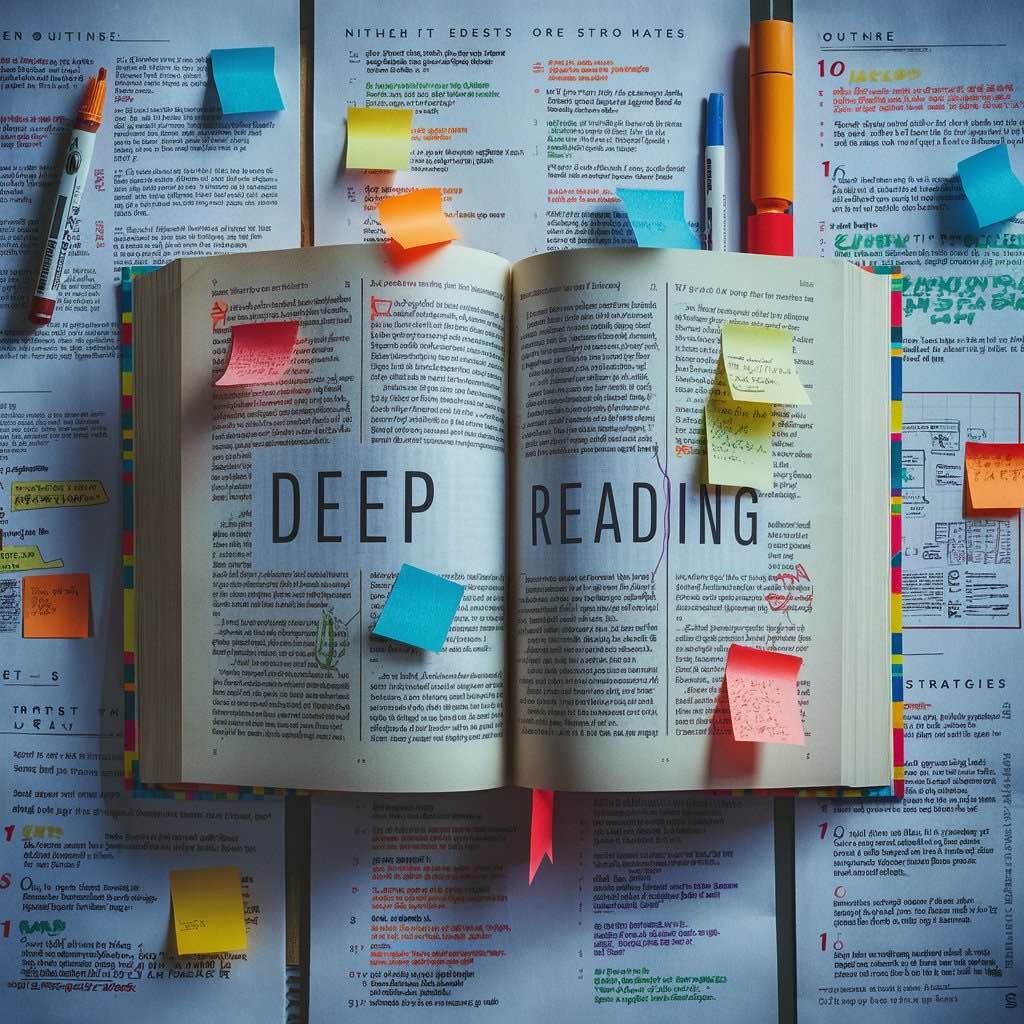[su_label type=”black”]Bookworm’s Notebook[/su_label]
[su_box title=”Key Takeaways” style=”soft”]
[su_list icon=”icon: check” indent=”4″]
- Annotating a book enhances comprehension and retention by engaging readers deeply with the text. Essential tools include highlighters, pens, sticky notes, bookmarks, and digital tools.
- Techniques like highlighting, writing marginalia, and making side notes help personalize the reading experience.
- Organize annotations through:
– Color-coding
– Symbol systems
– Mapping ideas - Reviewing involves:
– Summarizing key points
– Creating study guides
– Sharing insights - Respect the book by balancing notes with preservation. Use:
– Pencils for erasable marginalia
– Non-bleeding highlighters
– Sticky notes - Alternatives to writing directly in books include:
– Separate notebooks for extensive notes
– Digital tools with built-in annotation features
[/su_list]
[/su_box]
When it comes to truly engaging with a text, annotating a book is a transformative strategy. Readers often find that marking up their pages with marginalia, text highlights, doodles, and scribbles enriches their comprehension and retention of the material. Annotating a book allows individuals to interact intimately with the text, making connections and noting insights directly on the pages.
Different methods of annotation, such as using pens, highlighters, or sticky notes, offer unique ways to personalize the reading experience. By writing in the margins or using symbols and colors, readers can emphasize key ideas and track their thoughts. These annotations serve as a valuable reference for future review and discussion.
Whether for academic purposes, personal reflection, or sheer enjoyment, the practice of annotating begins with choosing the right tools and techniques to suit one’s needs. Exploring various annotation styles can lead to discovering the most effective way to engage with and remember the content of the reading material.
Choosing the Right Tools
Choosing effective tools is essential for annotating a book. The right tools can help you highlight important text, add marginalia, and organize your thoughts.
Highlighters & Pens
Highlighters and pens are among the most common tools for annotating. Highlighters are perfect for emphasizing critical passages and making sections stand out. Using different colors can help categorize various themes or subjects, making it easier to locate specific information later.
Pens, preferably with fine tips, allow for detailed marginalia. Writing notes directly in the margins can provide context and insight. For those who prefer erasable options, there are special pens designed for making temporary annotations.
Sticky Notes & Bookmarks
Sticky notes offer flexibility and removable options for those who do not want to write directly in their books. These can be used to jot down thoughts, questions, and reflections and then placed on relevant pages.
Bookmarks with attached sticky flags can also mark important sections, keeping the text organized without permanent alterations. Some readers use color-coded flags to differentiate between different types of notes, such as plot points, character development, or personal reflections.
Digital Tools for Ebooks
For ebook readers, digital tools provide a range of annotating options. Most e-readers come with built-in features for highlighting text, adding notes, and bookmarking pages. These digital highlights and annotations are often searchable, making it incredibly easy to find specific information quickly.
Programs and apps like Kindle, iBooks, and Adobe Acrobat allow users to write marginalia in the digital margins. Additionally, cloud storage options can back up annotations, ensuring you never lose valuable notes.
Understanding the Purpose of Annotation
Annotating a book involves a range of techniques like marginalia, text highlights, doodles, and scribbles. These practices engage readers deeper with the text, enhancing comprehension and retention.
Active Reading
Active reading through annotation transforms the reading experience from passive to interactive. By taking notes, highlighting passages, and asking questions in the margins, readers engage with the text dynamically. This active participation helps readers stay focused and better grasp complex ideas. Annotation allows readers to interact with the material, fostering a dialogue between the reader and the text.
Study & Review
Annotations play a crucial role in studying and reviewing material. They make it easier to locate important information quickly. Highlighting key terms, annotating definitions, and summarizing sections in the margins can save time when revisiting the material. This method ensures that essential concepts are readily accessible.
Critical Thinking
Annotating a book sharpens critical thinking skills. By writing down their thoughts and questions, readers can analyze the text more thoroughly. This process helps in identifying themes, drawing connections, and challenging ideas presented in the book. Annotations encourage readers to reflect on the content, helping them form well-rounded opinions based on textual evidence.
Different Annotation Techniques
Annotations play a vital role in enhancing comprehension and engagement with texts by incorporating varying methods such as highlights, marginal notes, and side notes. Understanding these techniques is crucial for developing deeper connections with what you’re reading.
Highlighting Methods
Highlighting is an effective starting point for those new to annotating. This method involves marking significant passages with colors to identify key themes, concepts, or quotations.
Color-coding can offer a structured approach:
- Use yellow for the main ideas.
- For supporting details, go with light blue.
- Pink can denote personal reactions.
To avoid clutter, highlighters should be selective. Focus on ideas that are critical to the text, resonant, or require further reflection.
Writing Marginalia
Marginalia refers to the practice of writing notes in a book’s margins. This technique allows readers to engage directly with the text by adding personal observations, questions, or summaries.
- Summarize complex paragraphs in a few words.
- Question the author’s claims to encourage critical thinking.
- Personal reflections can link content to one’s own experiences or knowledge.
Marginalia turns passive reading into an active dialogue with the text, making the reading experience more immersive and thoughtful.
Making Side Notes
Making side notes involves jotting down thoughts on sticky notes, notebooks, or separate sheets of paper. Side notes offer flexibility, especially for those reluctant to write in books.
Consider these practices:
- Use sticky notes for temporary comments that can be repositioned or removed.
- Keep a dedicated notebook where you log each side note along with the page numbers for reference.
- Summarize chapters or sections in bullet points for quick recall.
Side notes provide a less intrusive yet effective way to annotate, ensuring that one’s reflections and questions are organized and accessible.
These techniques—highlights, marginalia, and side notes—collectively empower readers to interact more deeply with texts, fostering enriched understanding and retention. Through thoughtful annotations, one can better navigate and appreciate the layers of meaning within any book.
Organizing Your Annotations
Effective organization of your annotations can enhance your understanding and retention of the material. Here, we will discuss several methods to keep your annotations clear and structured.
Color-Coding
Color-coding is an excellent way to categorize and organize your highlights. By assigning different colors to various themes or types of information, readers can easily navigate through the book. As mentioned earlier, you can use blue to emphasize supporting ideas and highlight key concepts with yellow.
Using a consistent system is crucial. It allows for quick reference and helps avoid confusion. Many readers use a highlighter in the book itself, but sticky tabs or colored pens can also serve as effective tools for color-coding.
Symbol System
A symbol system simplifies marking key ideas without overcrowding the margins. Common symbols include stars for crucial points, question marks for queries, and exclamation marks for surprising or noteworthy information.
This method keeps annotations concise while ensuring that important information stands out. Consistency is again key here; ensure the symbols you choose are intuitive and memorable. Incorporating a legend at the beginning of your annotation notebook can be helpful.
Mapping Ideas
Mapping ideas involves creating visual diagrams or charts to link related concepts and track character development or plot progression. This technique is particularly useful for complex texts with intricate themes or numerous characters.
Readers may employ tools such as mind maps, flowcharts, or even simple lists in the margin or a separate notebook. This approach allows for a deeper engagement with the text, facilitating a more comprehensive understanding.
Reviewing Annotated Material
When revisiting annotated materials, one can uncover key insights and organize information effectively. Reviewing annotations further ensures comprehension and retention of complex concepts.
Summarizing Key Points
Annotations allow readers to identify and highlight crucial concepts within the text. When reviewing these notes, readers should:
- Identify the central themes and ideas noted during the initial reading.
- Extract the main arguments and supporting evidence.
- For quick reference, list key terms and their definitions.
Creating brief bullet points or condensed paragraphs that capture the essence of the annotated material can help summarize these points. This step ensures that essential information is readily accessible for future recall.
Creating Study Guides
For academic purposes, turning annotations into comprehensive study guides is invaluable. These guides can include:
- Outline of chapters based on the marginal notes.
- Highlighted passages transcribed into organized sections.
- Personal comments and questions, fostering critical analysis.
To enhance study efficiency, again consider visual aids like mind maps or charts. Incorporating various forms of book markings, including text highlights and scribbles, can make study guides more engaging and useful.
Sharing Insights
Annotated books are also beneficial for group discussions and collaborative learning. When sharing insights:
- Discuss key passages and notes with peers to gain diverse perspectives.
- Use annotated points as references during academic discussions.
- Collaborate on expanding annotations, noting additional viewpoints and analyses.
This collaborative approach not only enhances one’s understanding, but also uncovers new interpretations and insights stemming from collective intelligence.
Respecting the Book
Annotations, whether they be marginalia, text highlights, or doodles, are valuable tools for engaging with a book. However, responsible annotations are necessary to respect and preserve the book for future readers, as well as to maintain its physical integrity.
Balancing Insight with Preservation
While annotating, it is crucial to strike a balance between making insightful notes and preserving the book’s condition. Personal annotations should enhance the reading experience without causing irreversible damage.
Using a pencil instead of a pen allows for erasure, making marginalia less permanent. Opting for highlighters that do not bleed through the pages helps maintain the book’s readability. Sticky notes or tabs can mark significant passages without touching the text directly, preserving its original state.
The use of a color-coding system can be particularly beneficial for avid annotators. But instead of actually highlighting the text on the page, using colored sticky notes does the job while still preserving the book’s structure.
Alternatives to Writing in Books
For those who prefer not to write directly in books, several alternatives exist to keep one’s insights organized and accessible. Maintaining a separate notebook for annotations can be an effective method. This allows for extensive note-taking without compromising the book’s condition.
Digital solutions also offer excellent alternatives. Ebooks often have built-in annotation features that enable users to highlight and make notes digitally. Mobile apps and other digital tools can sync notes across devices, making them convenient for reference.
Sticky notes and flags can also serve as temporary bookmarks to mark key sections or passages. These tools allow readers to jot down brief thoughts without touching the book’s pages and can be easily removed or adjusted as needed. This method keeps the book itself clean, while still allowing for a personalized reading experience.
Further Reading
Annotating My Books: Why and How I Take Notes While Reading by Mollie Reads
Diary of a Bookworm: Learn to annotate books aesthetically, mistake free by Julie Blunt, The State Hornet
A realistic guide to book annotation | 10 ways to annotate your books by Li’s Library, YouTube
Readers who annotate their books, why/how do you do it? on Reddit





